1. Introduction
The Lower Jurassic of the Lusitanian Basin (Western Portugal) shows a distinctive succession of carbonate deposits that are a stratigraphic reference at a global scale [e.g. Duarte et al. 2017; Hesselbo et al. 2007; Rocha et al. 2016]. Much of the research interest arises from the preferred palaeogeographic location of these deposits between the Tethyan and pre-Atlantic realms [Thierry and Barrier 2000], thus relevant for regional and global biostratigraphic correlations and palaeogeographic and palaeobiogeographic reconstructions [e.g. Ferreira et al. 2019; Rocha et al. 2016; Silva et al. 2021]. Except for its base, dated from the Sinemurian, the majority of the Lower Jurassic is composed of hemipelagic marly limestones with abundant benthic and nektonic macrofauna, formally organised in several lithostratigraphic units [e.g. Duarte and Soares 2002; Duarte et al. 2010; Silva et al. 2015]. These formations are biostratigraphically well constrained (ammonites, calcareous nannofossils and dinoflagellates biostratigraphy) and dated from the uppermost Sinemurian to the upper Toarcian [e.g. Correia et al. 2018; Dommergues 1987; Ferreira et al. 2019; Rocha et al. 2016]. In addition, a set of reference stable carbon isotopic curves, covering the Upper Sinemurian to Middle Toarcian, reinforces detailed regional and global correlation [e.g. Duarte et al. 2014a; Hesselbo et al. 2007; Oliveira et al. 2006; Silva et al. 2011, 2021; Suan et al. 2010].
A significant part of the Sinemurian is represented by the Coimbra Formation (Fm), a unit that integrates the lexicon of Portuguese stratigraphy since the late 19th century; the so-called “Couches de Coimbra” [Choffat 1880]. The Coimbra Fm is individualised on its dominant dolostone component, particularly evident towards the east, and represents the first evidence of sustained marine influence in the Lusitanian Basin. However, and despite its widespread cartographic distribution, a detailed stratigraphic analysis of this lithostratigraphic unit is lacking [e.g. Azerêdo et al. 2010; Dimuccio et al. 2016].
The most complete section of the Coimbra Fm crops out in the S. Pedro de Moel region (Figure 1A,B). It is dominantly calcareous [Figure 1C,D; Azerêdo et al. 2010; Duarte et al. 2014b] and contains organic-rich facies [Duarte et al. 2013; Poças Ribeiro et al. 2013] and few levels with ammonites [e.g. Dommergues et al. 2004, 2010]; therefore, this section holds great potential to perform an integrated stratigraphic analysis of the lowermost Sinemurian in the Lusitanian Basin.
(A) Location of the S. Pedro de Moel region in the Lusitanian Basin (central Portugal), showing the main Lower Jurassic outcrops. (B) Studied area and location of the two sections: 1. Praia Velha-Lighthouse; 2. Polvoeira. (C) Lithostratigraphic chart of the Sinemurian for the Lusitanian Basin [modified from Duarte et al. 2010, 2012]. (D) Synthetic stratigraphic log of the Sinemurian–lower Pliensbachian succession in S. Pedro de Moel [modified from Azerêdo et al. 2010; Duarte et al. 2012, 2014a]. VF—Vale das Fontes Fm; MLUP—Marls and limestones with Uptonia and Pentacrinus member [see Duarte et al. 2010].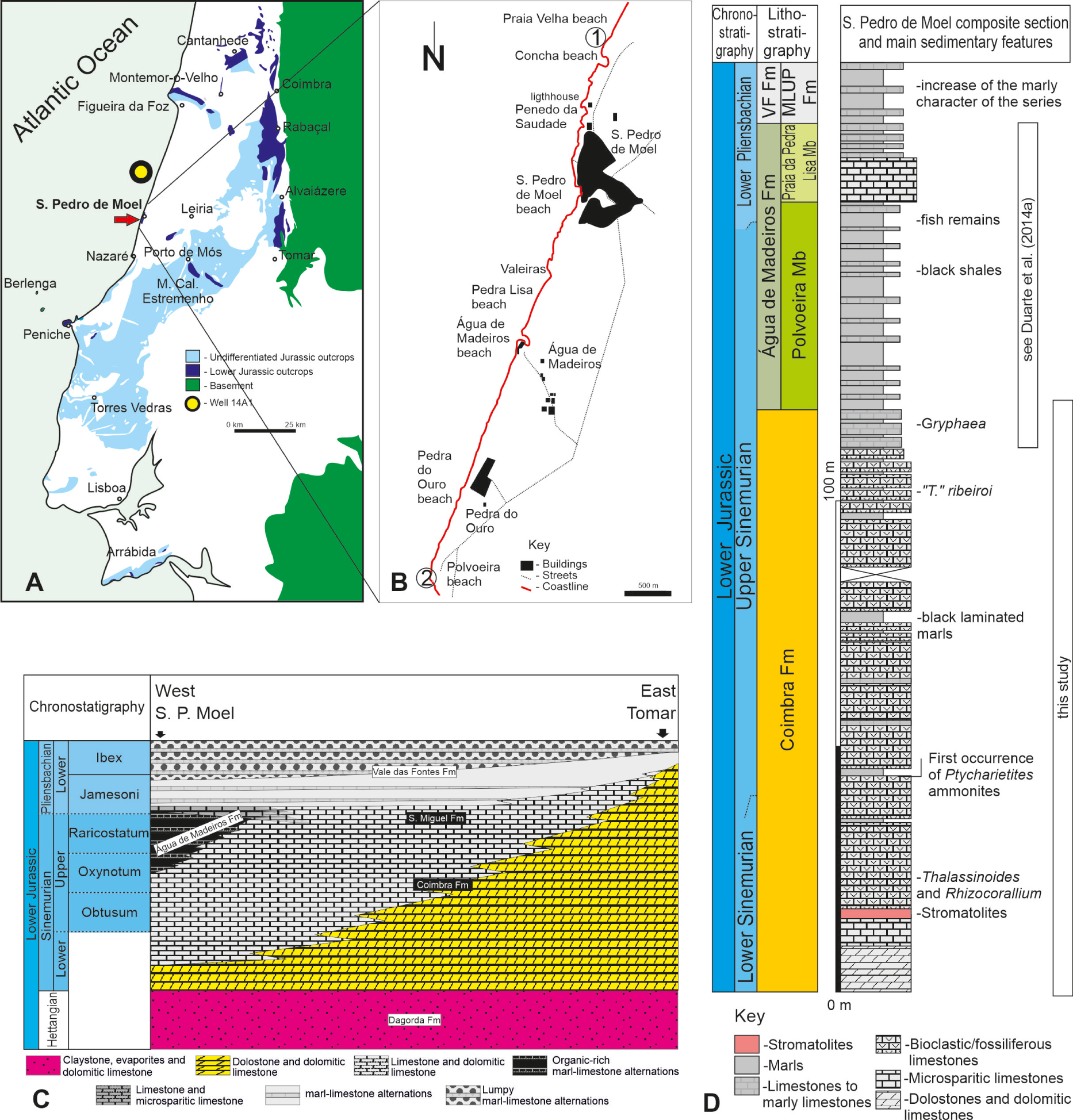
This paper, based on the analysis of the Lower Jurassic outcrops at S. Pedro de Moel, has three main goals: (i) to improve the lithostratigraphy and biostratigraphy of the Coimbra Fm, (ii) to perform a chemostratigraphic analysis of the studied sections based on stable carbon isotopes from bulk carbonates and total organic carbon (TOC), and (iii) to contribute to a better understanding of the Portuguese sedimentary record potentially associated with the hyperthermal Liasidium Event, such as recently recognised by Hesselbo et al. [2020], Munier et al. [2021] and Riding et al. [2013]. According to these authors, this hyperthermal event is characterised by an abundant record of the marine dinoflagellate cyst Liasidium variabile and the pollen grain Classopollis classoides, associated with a negative carbon isotope event.
2. Geological setting
The Lusitanian Basin, located in the western Iberian Margin, hosts a thick sedimentary succession dated from the Middle (?) Triassic to the Upper Cretaceous [e.g. Hiscott et al. 1990; Kullberg et al. 2013]. Except for the Hettangian lutitic and evaporitic deposits of the Dagorda Fm, the Lower Jurassic is represented by a thick succession of dolostones, limestones, and calcareous mudstones (up to 500 m thick), where several lithostratigraphic units are formalised [e.g. Dimuccio et al. 2016; Duarte and Soares 2002]. Framed between the Hettangian Dagorda Fm and Pliensbachian hemipelagic marls and marly limestones, the base of the Sinemurian marks the beginning of carbonate deposition in the Lusitanian Basin in a shallow-water carbonate ramp [Azerêdo et al. 2010; Dimuccio et al. 2016; Duarte et al. 2014b; Sêco et al. 2018; Soares et al. 1993]. These carbonates belong to the Coimbra Fm, consisting mainly of dolostones and dolomitic limestones to the east and is dominated by limestone in the westernmost sectors of the basin [Dimuccio et al. 2016; Duarte et al. 2010; Figure 1C,D], including some thick marly intervals. Here, the Coimbra Fm is overlain by an upper Sinemurian–lowermost Pliensbachian marl–limestone unit rich in organic matter, the Água de Madeiros Fm [Duarte et al. 2010]. The Água de Madeiros Fm is particularly well exposed in the S. Pedro de Moel region and is the most representative of the latest Sinemurian age in Portugal [Duarte et al. 2014a, b; Figure 1C,D].
The most complete Sinemurian succession of the Lusitanian Basin crops out at S. Pedro de Moel. In this region, the Coimbra Fm is visible on both flanks of a fractured km-scale syncline exposed along the coastline (Figure 1B). At the Praia Velha Beach, located to the north of the S. Pedro de Moel Village and at the northern cropping out edge of the syncline, the base of the Coimbra Fm is highly fractured and folded, in a succession dipping towards the west [see Azerêdo et al. 2010; Cabral et al. 2015; Dommergues et al. 2004, 2010; Duarte et al. 2014b]. In the southern part of the syncline, at the Polvoeira Beach, the uppermost part of the Coimbra Fm is continuous [Figures 1B and 2; see also Duarte et al. 2012, 2014b; Paredes et al. 2013, 2016] and includes the transition to the overlying Água de Madeiros Fm [Duarte et al. 2010, 2012, 2014a].
(A) General composite section of the Coimbra Fm (lower to upper Sinemurian) in the S. Pedro de Moel region. (B) Detailed stratigraphic columns of UE to UG (Lighthouse section) and UH (Polvoeira section). For more information about UA–UD, see Azerêdo et al. [2010]. Epophioceroides occurrences from Dommergues et al. [2010].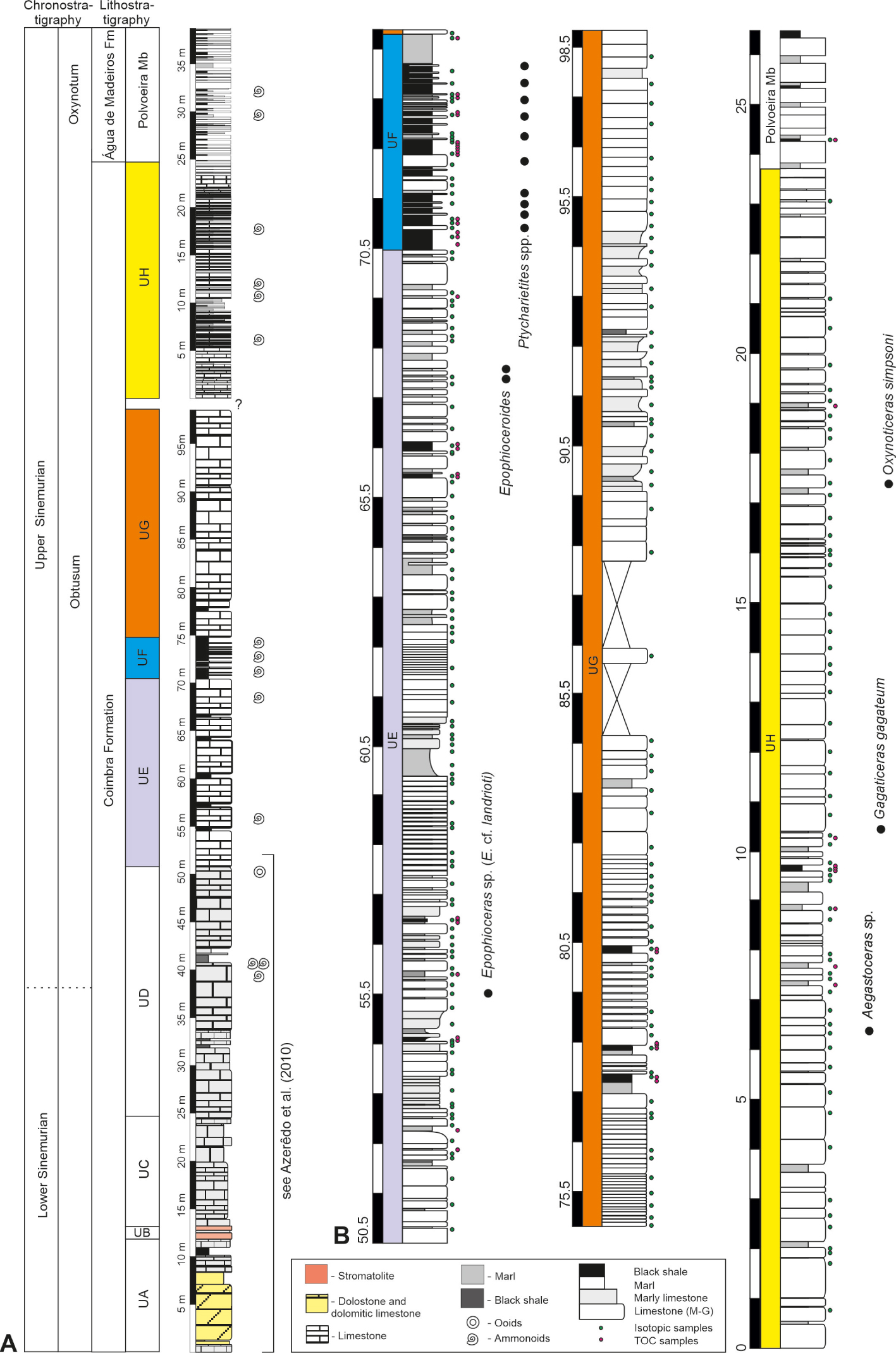
The base of the Coimbra Fm was previously described by Azerêdo et al. [2010], who identified four subunits (UA to UD). Later, in a preliminary work, Duarte et al. [2014b] described the upper part of the formation and identified four other units (UE to UH). Units UA to UG are observed from the Concha Beach to the S. Pedro de Moel Lighthouse (the latter also known as Penedo da Saudade) section (coordinates: 39° 46′ 11.12′′ N; 9° 1′ 38.70′′ W), whereas UH occurs only at Polvoeira Beach (coordinates: 39° 43′ 8.74′′ N; 9° 3′ 0.10′′ W) (Figures 1B and 2). According to the ammonite record [see Dommergues et al. 2004, 2010; Duarte et al. 2014b], the Coimbra Fm in this region is dated from the lower to upper Sinemurian. Previous studies in this region have also focused on ostracod assemblages [Cabral et al. 2013, 2015], organic and petrographic geochemistry [Brito et al. 2017; Duarte et al. 2013; Poças Ribeiro et al. 2013] and gamma-ray analysis [Sêco et al. 2018].
3. Material and methods
This study focuses on the stratigraphic, sedimentologic and geochemical analysis of the Coimbra Fm at S. Pedro de Moel, through the examination of the Praia Velha and Polvoeira sections [Figures 1B and 2; see Azerêdo et al. 2010; Duarte et al. 2014b].
3.1. Stratigraphy and sedimentology
This study expands the sedimentological and lithostratigraphic description of the Coimbra Fm previously addressed in Azerêdo et al. [2010] and Duarte et al. [2014b]. This was achieved through new stratigraphic and sedimentological observations from the middle–upper part of the Coimbra Fm in the upper part of the Praia Velha-Lighthouse and Polvoeira sections. Field observation and sedimentological descriptions were complemented by microfacies synthetic characterization of 77 thin sections using a Nikon Eclipse polarised light microscope coupled with a Nikon digital microscope camera at the Department of Earth Sciences of the University of Coimbra. In addition, new ammonites were collected and identified.
3.2. Total organic carbon (TOC) and total sulphur (ST)
Insoluble residue (IR), total organic carbon (TOC) and total sulphur (TS) content were measured in 67 samples of grey to dark grey to black mudstone/marlstone (black shales) using a Leco-SC144 analyser and following the standard laboratory protocols of the Palynofacies and Organic Facies Laboratory of the Federal University of Rio de Janeiro [e.g. Mendonça Filho et al. 2012]. A higher resolution sampling scheme was used where the black shale lithology was more evident.
3.3. Carbon and oxygen stable isotopes
Carbon (δ13Ccarb) and oxygen (δ18Ocarb) stable isotopes ratios were analysed on 292 bulk carbonate samples. Due to the thickness of the studied succession and facies heterogeneity, samples were collected from micritic sediments and with an average sampling resolution of about one (1) meter, reduced to about 0.3 to 0.5 m in the middle to upper part of the series. Sample aquilots were selected to avoid shell fragments and hand-drilled in the laboratory to avoid sparitic cement. Stable oxygen and carbon isotopes were analysed at Iso-Analytical (UK). Isotopic results are presented in per mil (‰) standard notation (δ) relative to the Vienna PeeDee Belemnite (V-PDB). Reproducibility based on standards is better than 0.2‰ for both δ18Ocarb and δ13Ccarb. The reference materials used during analysis were IAR022 (Iso-Analytical working standard calcium carbonate, δ13C = −28.63‰ and δ18O = −22.69‰), NBS-18 (carbonatite, δ13C = −5.01‰ and δ18O = −23.2‰) and IA-R066 (chalk, δ13C = +2.33‰ and δ18O = −1.52‰). IA-R022 was calibrated against and is traceable to NBS-18 and NBS-19 (limestone, δ13C = +1.95‰). IA-R066 was calibrated against and is traceable to NBS-18 and IAEA-CO-1 (Carrara marble, δ13C = +2.5‰). NBS-18, NBS-19 and IAEA-CO-1 are inter-laboratory comparison standard materials distributed by the International Atomic Energy Agency (IAEA).
4. Results
4.1. Stratigraphy and sedimentary characterisation
Integration of the two studied sections from S. Pedro de Moel allows inferring a minimum thickness of about 125 m (∼100 m thick in the Praia Velha - Lighthouse section and ∼25 m in the Polvoeira section) for the Coimbra Fm in this area of the Lusitanian Basin. The limitations to this observation refer to the fact that the boundary with the underlying Dagorda Fm is not visible here and there is a gap of observation between the two sections (Figure 2). In this region, the Coimbra Fm is subdivided into eight units (UA to UH; Figure 2). The main stratigraphic and sedimentological characteristics are described below. For more detail about units UA to UD see Azerêdo et al. [2010] (Figure 3A,B).
(A) Base of the Coimbra Fm at Praia Velha with stromatolites (UB), see also Azerêdo et al. [2010]. (B) Panoramic view of UC and UD at Concha Beach (white arrow: first level with Ptycharietites). (C) Base of UE showing a discrete level of black shale (white arrow). (D) Panoramic view of the thick black shale interval of UF, framed by UE and UG (just north of Lighthouse). (E) Uppermost part of UG around the Lighthouse, and location of Polvoeira Beach (red arrow). (F) Limestones enriched in brachiopods and bivalves of the base of UH at Polvoeira Beach.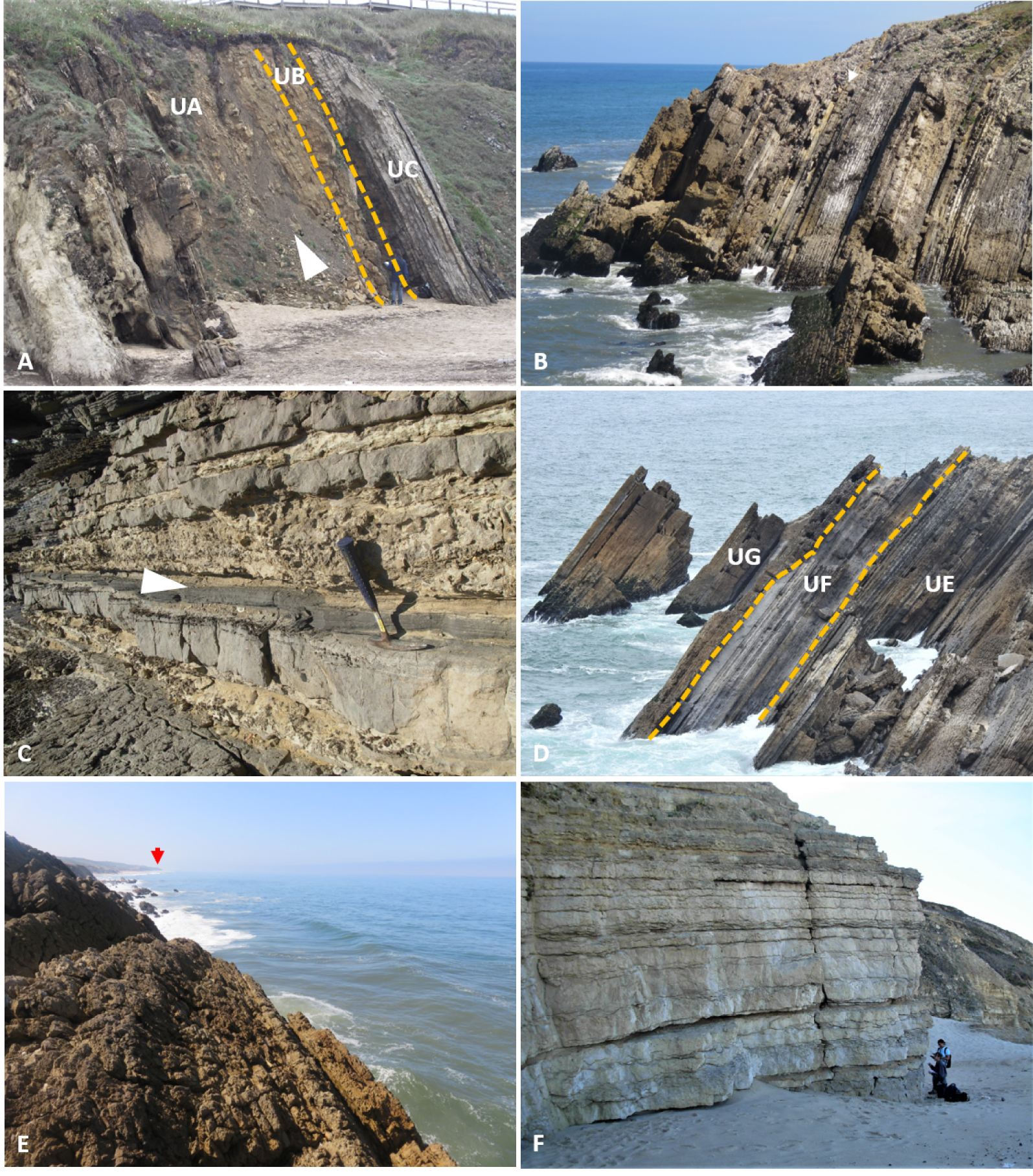
UA (∼12 m)
Comprises a large diversity of dolomitic and limestone facies and textures (mudstone to grainstone), locally fossiliferous, including mainly bivalves and gastropods. Organic-rich marly intervals occur at the top of UA, alternating with laminated calcareous-dolomitic centimetric beds (Figure 3A).
UB (1.5 m)
Mainly composed of decimetric- to metric-scale domiform stromatolites, including centimetre micritic limestones and marly limestones (mudstones and wackestones) and a few centimetre-thick intervals of wacke-packstones (Figure 3A).
UC (11.3 m)
Alternation of marly, micritic, and bioclastic limestones, with rare levels of ostracod-rich marls, sometimes intensely bioturbated by Rhizocorallium and Thalassinoides. Some grainstone levels, generally thin (centimetric-scale), are enriched in Unicardium sp. and ostreids (Figure 3A,B).
UD (25.7 m)
With a facies arrangement similar to UC, UD includes rare marly levels (with ostracods) and fossiliferous limestones and coquinas of Unicardium costae and gastropods (Figure 3B). Some levels are intensely bioturbated with Thalassinoides and Rhizocorallium (Rhizocorallium commune var. irregulare [Knaust 2013]; Figure 4A). The first ammonoids occur at around 40 m [Asteroceras sp. and some species of the Ptycharietites genus, see Dommergues et al. 2004, 2010] (Figures 3B and 4B), associated with an organic-rich marly interval. This unit ends with decimetric limestone beds of oosparites/grainstone.
Relevant sedimentary and stratigraphic aspects of the Coimbra Fm at S. Pedro de Moel: (A) Intense bioturbated level of UD with Rhizocorallium commune var. irregulare [Knaust 2013]. (B) Surface with a high concentration of Unicardium sp. and Ptycharietites sp. (see text). (C) Sharp transition between UE and UF (white arrow). Noteworthy are the decimetric levels of organic-rich marls of the base of UF. (D) The most organic-rich horizons observed in UH.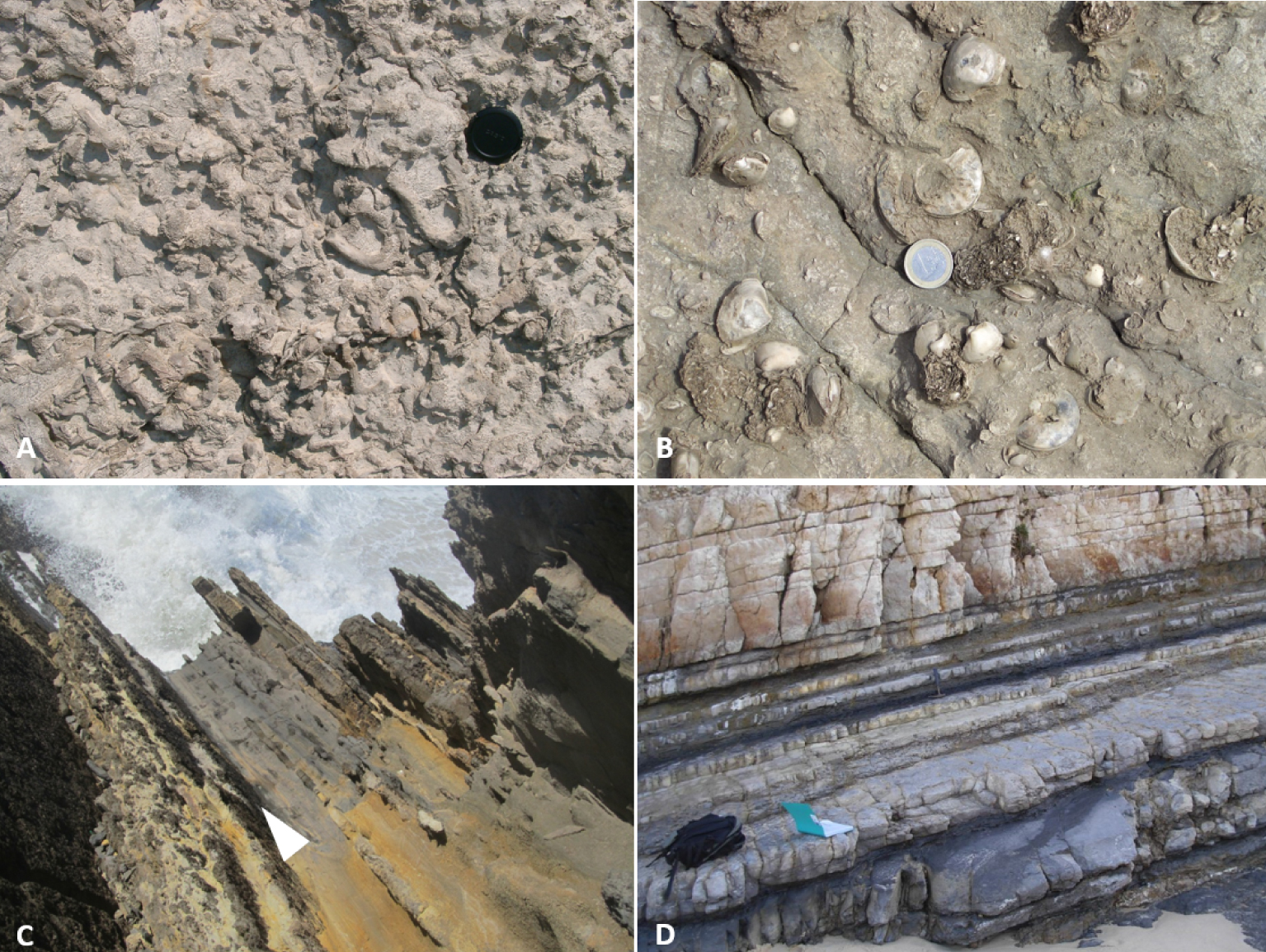
UE (∼20 m)
This unit mainly comprises limestone, generally composed of centimetric and irregular beds, locally intensely bioturbated and bioclastic, sporadically alternating with marly interbeds that can reach few decimeters in thickness, some corresponding to black shales (Figure 3C,D). Limestone lithotypes range from fossiliferous micrites to biopelsparites/grainstone. Despite occurrences of gastropods and echinoids, fossil macrofauna is dominated by bivalves (Unicardium costae, ostreids) forming several levels of coquinas. Bioturbation is a constant feature of this unit with Rhizocorallium and Thalassinoides. Two horizons with rare ammonoids [including Epophioceroides apertus in Dommergues et al. 2010] were identified in this unit.
UF (4.4 m)
Corresponds to the marliest part of the Coimbra Fm and includes well defined laminated organic-rich facies (black shales) alternating with centimetric bioclastic limestone beds (biomicrites to pelsparites, packstone–grainstone) (Figures 3D and 4C). Similarly to the previous units, benthic macrofauna is dominated by bivalves (Unicardium costae, ostreids), although restricted to some of the limestone beds. This interval of the Coimbra Fm is particularly rich in ammonoids, including several species of the genus Ptycharietites [Dommergues et al. 2010].
UG (>24 m)
Composed of metric sets of centimeter layers of micritic and bioclastic limestones interbeded at the base with centimetric dark grey, organic-rich, marly limestones. The microfacies vary from grainstones, fossiliferous and intraoosparite micrites with different textures to mudstones. Fossiliferous and bioclastic facies (essentially bivalves) and bioturbated levels (mainly Rhizocorallium) are of less importance when comparing with the previous units. The intermediate portion of this unit is of difficult access (Figure 3D,E).
UH (>25 m)
This unit is restricted to the Polvoeira Beach (Figure 3E,F) and is composed of decimetric micritic limestone (fossiliferous micrites/mudstone to biomicrites/packstones)/millimetric-centimetric marl (sometimes organic-rich; Figure 4D) alternations. This succession contrasts with previous units of the Coimbra Fm because of its greater diversity of benthic macrofauna and the first record of brachiopods. Faunal assemblages include bivalves (some species of Pholadomya, Mactromya, Unicardium), brachiopods (specimens of “Terebratula” ribeiroi and the genus Zeilleria and Cincta), gastropods, crinoids, and rare ahermatypic corals [see also Paredes et al. 2013, 2016; Vitón et al. 2020]. Although less frequent than in other units (e.g. Units C to E), bioturbation is sometimes intense, consisting mainly of Thalassinoides, Rhizocorallium and Diplocraterium. Although extremely rare, ammonites occur according to the sequence of the following genus Aegasteroceras, Gagaticeras and Oxynoticeras (Figure 2).
4.2. Total organic carbon and ST
Total organic carbon contents determined in 67 marly horizons show that several levels of the Coimbra Fm are rich in organic matter. Except for UC, all units have TOC contents above 1 wt% (Figure 5 and Supplementary Table 1). In UA and UF (Figures 3A,C,D and 4C), TOC contents reach up to 6 wt% (∼10.6 m) and 9 wt% (∼72.9 m), respectively. The highest TOC contents were determined in discrete levels of the thicker UG and UE, reaching up to ∼12 wt% (∼77.7 m) and ∼10 wt% (∼65.87 m), respectively. The highest TS contents were determined in UF (3.0 wt%) and at the base of UG (2.8 wt%). Total sulfur contents of the remaining units are generally below 1 wt%. The carbonate content of the marly intervals is variable across the succession (Table 1 in Supplementary Material). The marly intervals of UA are those with lower carbonate content, where the siliciclastic contribution reaches up to 70% (insoluble residue). Insoluble residue contents decrease upwards, with the marly intervals of UH presenting contents generally below 20%.
TOC variation, bulk carbonate carbon isotopic curve, and sequential interpretation [2nd and 3rd-order transgressive (3rd O T) and regressive (3rd O R) cycles] across the Coimbra Fm cropping out at S. Pedro the Moel. AC—Ammonite Chronozone; AS—Ammonite Subchronozone.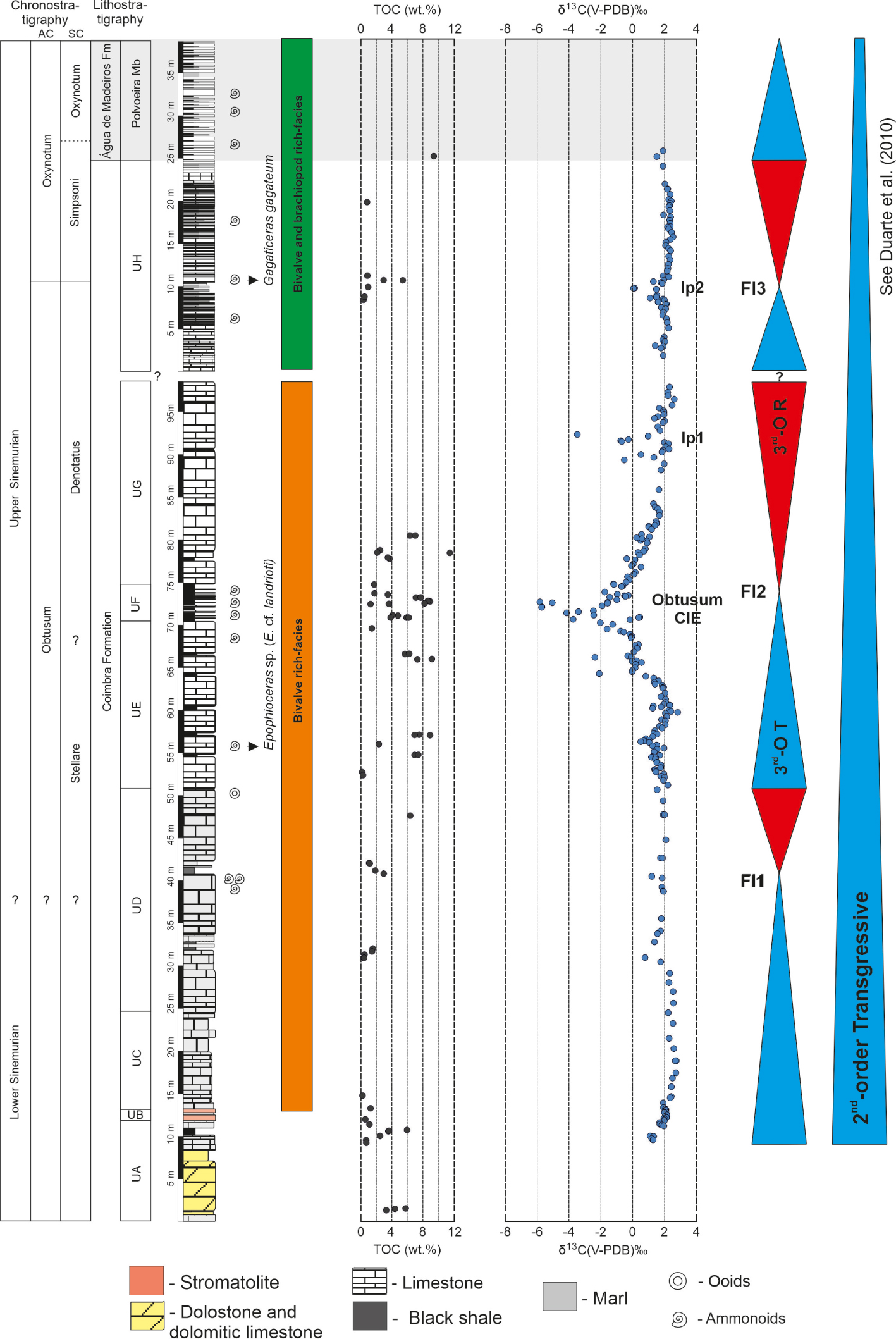
4.3. C and O stable isotopes in bulk carbonate
δ13Ccarb from the Coimbra Fm ranges from − 5.8‰ (73.21 m) to 2.8‰ (60.46 m) (Table 1 in Supplementary Material). The carbon-isotope curve shows little variation (around 2‰) except for a high amplitude negative excursion in UF (Figure 5). The lower (UA to middle part of UE) and upper (UG and UH) parts of the isotope curve are largely characterised by positive δ13Ccarb values, around 2‰. The most pronounced negative excursion, with an amplitude of ∼8‰ (Figure 5), is observed in the organic-rich marly interval of UF. Less expressive is the negative excursion of ∼6‰ at the top of unit G (∼92.65 m) (IP1; Figure 5). Another very singular small negative peak in δ13Ccarb is associated to the enriched organic horizons observed in UH (IP2; Figures 4D and 5).
δ18Ocarb values are quite negative, ranging from − 7.5‰ to − 2.6‰, but with less significant fluctuations than those of carbon isotopes. The most negative values of δ18Ocarb are mainly within the microbialites of UB and in some parts of the UD units. On the other hand, at the top of the Coimbra Fm (UH) δ18Ocarb values are more homogeneous and considerably higher than in the rest of the stratigraphic succession (Table 1 in Supplementary Material). Despite the low values of δ18Ocarb, quite negative, there is no correlation with the δ13Ccarb data, as confirmed by the Pearson R2 = −0.094 (Figure 1 in Supplementary data).
5. Discussion
5.1. Biostratigraphic additions and thickness of the Coimbra Fm
The lithological and facies succession of the Coimbra Fm in the S. Pedro de Moel area is unique within the Lusitanian Basin [e.g. Azerêdo et al. 2010; Duarte 2004; Duarte et al. 2014b]. The vertical facies variation allows for a detailed palaeoenvironmental assessment and sequence stratigraphic interpretation. In addition, and despite the rarity of age-diagnostic ammonites, this is the only basin area where the biostratigraphic record allows dating the Coimbra Fm, although a large part of the ammonite record is endemic [Dommergues et al. 2004, 2010; Mouterde and Ruget-Perrot 1975]. This work is the first to present a detailed stratigraphic analysis of the entire succession, allowing us to add new ammonite data and improve the upper Sinemurian biostratigraphic scheme for the western Iberian margin.
This work confirms the previous studies of Dommergues et al. [2004, 2010], indicating that a large part of the Coimbra Fm in the study area is dated from the Obtusum Chronozone. Ammonites, also the oldest occurrence in the Lusitanian Basin, are mainly restricted to the top of UD [Asteroceras sp. and Ptycharietites species; see Dommergues et al. 2010] and the UF (Ptycharietites species). Except for one horizon of UE (with Epophioceras sp. (E. cf. landrioti)), all taxa are endemic, making it difficult to draw correlations with the northwestern European basins [e.g. Corna et al. 1997; Page 2003]. However, according to the standard zonation, the new found specimen of Epophioceras sp. (E. cf. landrioti) in the lower part of UE (at 56 m in Figures 2 and 5) indicates the middle part of Stellare Subchronozone.
Occurrence of Aegasteroceras, Gagaticeras, and Oxynoticeras [Figure 3; genus characteristic of the northwestern European basins, Comas-Rengifo et al. 2021; Hesselbo et al. 2020; Howarth 2002] in UH allows assigning the top of the Coimbra Fm to the transition between the Obtusum and Oxynotum (Simpsoni Subchronozone) chronozones, as also recently noted by Comas-Rengifo et al. [2021] for the Asturias Basin, northern Spain. The presence of Oxynoticeras simpsoni undoubtedly marks the Simpsoni Subchronozone of the Oxynotum Chronozone. Comas-Rengifo et al. [2013] and Duarte et al. [2014a] noted that this ammonite Subchronozone extends to the basal part of the overlying Água de Madeiros Fm. In fact, the Oxynotum Chronozone shows Oxynoceratidae (O. gr. oxynotum, C. cf. accipitris), Eoderoceratidae (B. bifer) and Echioceratidae, an association that is recognised in the Oxynotum Subcrhonozone of Asturias [Comas-Rengifo et al. 2013, 2021; Duarte et al. 2014a].
Despite the overall uncertainty, the available biostratigraphic data show some important issues: firstly, the unusual thickness of the Obtusum Chronozone in S. Pedro de Moel. Considering the biostratigraphic uncertainty associated with the basal part of the succession and the lack of observation between UG and UH, the Obtusum Chronozone would be estimated to be about 90 m thick, much thicker when comparing with all other Lower Jurassic ammonite zones defined for the Lusitanian Basin [e.g. Duarte and Soares 2002] and the thickness of the same zone in other European basins [e.g. Comas-Rengifo et al. 2021, and references therein]; secondly, and according to the two main intervals with ammonites, and following Dommergues et al. [2010], the middle–upper part of the UD may be limited to the Stellare Subchronozone; this Subchronozone extends to the base of the UE (with the occurrence of Epophioceras sp. (E. cf. landrioti)).
The age of the lower part of Coimbra Fm, i.e., from UA to UC and base of UD (∼40 m), is unknown and is here informally assigned to the lower–initial upper Sinemurian. However, according to the recent stratigraphic reinterpretation based in gamma-ray spectrometry of the offshore well 14A1, located close to the studied outcrop (Figure 1A), the base of the succession at the Praia Velha Beach may correspond to the base of the Coimbra Fm [see Sêco et al. 2018]. In well 14A1, the Coimbra Fm is 150 m thick [Sêco et al. 2018]. This value contrasts with the approximately 125 m measured at S. Pedro de Moel, predicting that the gap observed between the top of the Praia Velha-Lighthouse succession and the base of the Polvoeira section may be important. However, and as indicated by the low gamma-ray values observed across UG and UH [see Sêco et al. 2018], carbonate sedimentation should characterise this interval, and lithologies should be very similar to the two units (UG and UH) mentioned above. Another unanswered issue is the location and nature of the boundary with the Dagorda Fm, which is not visible in the area.
5.2. Organic matter deposition
The new geochemical data presented here substantiate the high TOC contents previously determined in some parts of the Coimbra Fm at S. Pedro de Moel [e.g. Brito et al. 2017; Duarte et al. 2013; Poças Ribeiro et al. 2013]. It is important to point out that both the Sinemurian and Pliensbachian of the Lusitanian Basin are known for the occurrence of organic-rich deposits, i.e. the Água de Madeiros and Vale das Fontes formations (Figure 1C), both potential hydrocarbon source rocks [e.g. Brito et al. 2017; Duarte et al. 2010, 2012, 2013; Oliveira et al. 2006; Poças Ribeiro et al. 2013; Silva and Duarte 2015; Silva et al. 2011, 2015, 2021; Sêco et al. 2018]. With the high TOC values (maximum of 12 wt%) determined in the present study, especially in the UA and UF (Figure 5), the importance of Coimbra Fm in this sector of the LB as a potential source rock, is also confirmed.
It is demonstrable that the characteristic Sinemurian shallow-water and relatively high-energy carbonate deposition in the area [see also Azerêdo et al. 2010; Cabral et al. 2015] was interrupted by brief episodes of deposition under lower energy conditions, favouring the accumulation of argillaceous sediments and preservation of organic matter, sometimes with high concentrations of S and pyrite. Organic matter accumulation probably resulted from increased productivity and poorly oxygenated bottom water conditions that had their climax in UA and UF; the latter is the thickest black shale interval in the studied succession, with organic rich facies devoid of benthic macrofauna and ichnofossils (Figures 3A, 3C,D, 4C and 5). These two intervals were also identified in well 14A1 [see Sêco et al. 2018]. The organic-rich intervals, combined with other sedimentological attributes, are essential criteria in the sequence stratigraphic interpretation of the succession (see below).
Regarding the organic matter content and its characterization, Poças Ribeiro et al. [2013] presented an analysis of palynofacies and biomarkers that, despite being based on a small number of samples (nine from UE, UF and UH), allows a better understanding of the depositional environment. First, the kerogen assemblages of the samples rich in organic matter (with TOC values between 3 and 9 wt%) are dominantly composed of amorphous organic matter (generally above 80%) and only with a residual contribution of particles belonging to the Phytoclast Group (<3 wt%). According to Poças Ribeiro et al. [2013], deposition of the organic-rich facies occurred in a relatively restricted and low-energy shallow-water carbonate ramp. By opposition, samples with the lowest TOC contents (<0.5 wt%) are associated with a higher content of phytoclasts (>56%), indicating relatively more proximal deposition under oxidising conditions and with strong continental influence [see Poças Ribeiro et al. 2013]. These facies are an essential argument in the sequential interpretation of the entire Sinemurian succession (see below). The occurrence of marine palynomorphs (acritarchs, prasinophytes, etc.), despite a slight increase in the upper part of the Coimbra Fm, is of little relevance when looking at the overall sequential organisation. In the limited number of samples analyzed in terms of palynofacies in Poças Ribeiro et al. [2013] no reference is made to the occurrence of dinoflagellate cyst Liasidium variabile.
5.3. Palaeoenvironment and sequence stratigraphy
In the Mesozoic evolution of the Lusitanian Basin, the Coimbra Fm is the first unequivocal evidence of marine flooding at a basinal scale, related to the beginning of a carbonate ramp that will be maintained and developed until the end of the Middle Jurassic [see Azerêdo et al. 2014; Soares et al. 1993]. This unit is known for the dolomitic and calcareous-dolomitic facies that dominate a large part of the Sinemurian record in the eastern and proximal areas of the basin. These facies are associated with very restricted marine conditions [see Azerêdo et al. 2010; Dimuccio et al. 2016; Duarte et al. 2010]. On the other hand, in the more distal areas, as is the case of the study area, these facies are limited to the basal portion of the Coimbra Fm (UA and UB), evidenced by the occurrence of dolomitic and microbial (including stromatolites) facies with thin limestone levels displaying low-diversity assemblages of bivalves and gastropods, and typically brackish and restricted marine ostracods [see Azerêdo et al. 2010; Cabral et al. 2013, 2015]. The upwards disappearance of these facies is concomitant with an increase in marine macroinvertebrate fauna (essentially bivalves) in the overlying UC and UD, which also show dominance of marine ostracods, though still bearing restricted marine and even an interval with brackish ostracods. Overall, these features suggest common alternation between more restricted-marine and slightly more open-marine influence, the latter becoming increasingly stronger and indicating a gradual rise in relative sea level [Azerêdo et al. 2010; Cabral et al. 2013, 2015]. Sustained conditions of fully saline (euhaline) conditions and clear marine influence are observed in the uppermost part of the Coimbra Fm (UH), inferred from a marked increase in brachiopods diversity and the sporadic occurrence of ahermatypic corals [see also Paredes et al. 2013, 2016]. Frequent minor movements (induced by differential regional subsidence?), may have promoted the opening and closing pulses of the marine influence in the shallow environment, leading to the common changes from more restricted- into more open marine conditions [Azerêdo et al. 2010]. On the other hand, the disappearance of the endemic ammonite faunas [Dommergues et al. 2010] and the occurrence of Aegasteroceras sp., Gagaticeras gagateum, Oxynoticeras simpsoni, and Oxynoticeras oxynotum, recognised in other northwestern European basins, testifies a strong connexion/opening of the Lusitanian Basin to the neighbouring basins during the Oxynotum Chronozone.
At a broad scale within the basin, the sedimentological variation of the different subunits for the Coimbra Fm shows a sequential arrangement, highlighted by recognizing various sedimentary discontinuities and biofacies and the occurrence of the organic-rich intervals. Following the sequential interpretation of Duarte et al. [2010] for the overlying Sinemurian and Pliensbachian units [Água de Madeiros, Vale das Fontes and Lemede formations; see also Silva et al. 2015], the succession of the Coimbra Fm is part of the transgressive system tracts of a 2nd-order transgressive–regressive facies cycle with its maximum flooding interval around the Sinemurian–Pliensbachian transition [top of Polvoeira Member; see Duarte et al. 2010, 2014a]. This long-lasting transgressive phase involved three 3rd-order subordinate maximum flooding episodes, corresponding to the more argillaceous and organic-rich intervals of the succession, in the middle-upper part of UD (Fl1), UF (Fl2), and in the lower-middle part of UH (Fl3) (Figures 3D, 4B–D and 5). Despite their endemic character, the first two phases of flooding are associated with abundant ammonites (Figure 4B,C). According to the available ammonite data [also based on Dommergues et al. 2010], the sedimentary record of these flooding events (Fl1, Fl2 and Fl3) are tentatively dated from the Obtusum Chronozone, with the latter close to the Obtusum–Oxynotum chronozones boundary.
5.4. Stable carbon isotope chemostratigraphy and organic matter preservation events (OMPIs)
The stable carbon isotopic data from bulk carbonate presented here for the lower?–upper Sinemurian exposed at S. Pedro de Moel mostly fall within the normal range for carbonate deposits of marine origin, between 0 to 2.5‰ [e.g. Marshall 1992]. Vertically, the δ13Ccarb curve shows several negative excursions (Figure 5). The largest of these (with an amplitude of about 8‰) is observed between UE–UG (∼25 m), another relatively large amplitude excursion was previously observed around the Sinemurian–Pliensbachian boundary [see Duarte et al. 2014a].
These two negative δ13Ccarb negative excursions are coincident with organic-rich facies. The same is true for the slight shift (IP2) recorded in the most organic-rich part of UH (Figure 5). Considering the relationship between negative δ13Ccarb and organic matter deposition, and as previously discussed in Duarte et al. [2014a] for the younger negative excursion contemporaneous with the Sinemurian–Pliensbachian boundary event [S-PBE cf. Korte and Hesselbo 2011], it is here interpreted that the marked increase bulk carbonate 12C in these intervals (when comparing with the rest of the succession) is likely due to oxidation of organic matter (via anaerobic bacteria for example) and incorporation of organic-related 12C enriched carbon into diagenetic carbonates [e.g. Marshall 1992]. Although in the case of the Sinemurian–Pliensbachian negative excursion this effect is most evident in a very small number of carbonate beds of clear early diagenetic origin, (likely influenced by anaerobic oxidation products of organic matter), it seems much more pervasive in UF of the Coimbra Fm. In addition, and despite the absence of significant correlation between δ18Ocarb and δ13Ccarb (see above) suggesting that late burial diagenetic may have had little influence in the generality of stable carbon isotopic data, diagenetic influence in the isotopic signal of UF is particularly evident, highlighted in the better correlation between δ18Ocarb and δ13Ccarb, with a Pearson R2 = 0.7 (Figure 1 in Supplementary data). Therefore, the negative excursions in δ13Ccarb from the Coimbra Fm are likely of diagenetic origin and of local/basinal significance; the influence of products derived from the biological oxidation of organic matter in diagenetic carbonates makes it difficult to extract regional/global palaeoenvironmental information from these data, although this information might be imprinted in the observed trends. It is increasingly evident that δ13Ccarb curves are very sensitive to diagenetic alteration, and this must be taken into consideration when interpreting these data. Even if the observed excursions of the Coimbra Fm are contemporaneous of regional/global events, their amplitude, stratigraphic location, and absolute values are likely to be biased [e.g. Bougeault et al. 2017; Duarte et al. 2014a; Munier et al. 2021; Silva et al. 2011, 2021; Ullmann et al. 2022].
The organic-rich sediments of UD–UG were suggested to be contemporaneous with the regional late Sinemurian (Obtusum, Obtusum–Stellare) Organic Matter Preservation Interval [OMPI S5; Silva et al. 2021]. By extension, the younger negative carbon isotopic excursion and organic-rich sediments associated with the regional (superregional?) Sinemurian–Pliensbachian OMPI [see Silva et al. 2021] are well dated, both by ammonites and calcareous nannofossils [e.g. Boussaha et al. 2014; Duarte et al. 2014a; Ferreira et al. 2019] and are now also recognized in several European basins [e.g. Franceschi et al. 2019; Korte and Hesselbo 2011; Masetti et al. 2017; Mercuzot et al. 2020; Munier et al. 2021; Peti et al. 2017; Price et al. 2016; Schöllhorn et al. 2020; Silva et al. 2021; Ullmann et al. 2022]. For a review of the processes linking dissolved inorganic and organic carbon in seawater, the following sources may be referred to Silva et al. [2017, 2020, 2021].
A negative carbon isotope excursion (CIE) that has recently gained international relevance is the so-called Sinemurian Liasidium Event, dated from the Obtusum Chronozone (Denotatus Subchronozone)–Oxynotum Chronozone (Oxynotum Subchronozone) [Hesselbo et al. 2020; Riding et al. 2013] and characterized by the acme of the Liasidium variabile dinoflagellate and high abundances of Classopollis classoides, suggesting an association of high land and sea temperatures [Hesselbo et al. 2020; Munier et al. 2021; Riding et al. 2013; Schöllhorn et al. 2020; Storm et al. 2020]. Given the nature of the δ13Ccarb curve of the Coimbra Fm and its biostratigraphic uncertainty, a correlation with data from neighbouring basins is, at this stage, ill-advised. Isotopic studies in different carbon-bearing substrates are ongoing; it was previously suggested that the organic-rich interval of UH (or even part of UF–UG) could correspond to the Early Jurassic Sinemurian Liasidium Event [Silva et al. 2021].
6. Conclusions
From an integrated stratigraphic analysis of the Lower Jurassic carbonate succession (Coimbra Fm) of the Lusitanian Basin cropping out at S. Pedro de Moel, the following conclusions are drawn:
- The Coimbra Fm shows a large diversity of calcareous facies and, less abundant, dolostones and shales, and is subdivided into eight informal units (UA to UF), rich in benthic macrofauna and deposited in a shallow-water carbonate ramp.
- The rare occurrence of ammonites, the majority endemic (genus Ptycharietites), allows assigning the Coimbra Fm to the lower?–upper Sinemurian (Simpsoni Subchronozone, Oxynotum Chronozone).
- Like the overlying Água de Madeiros Fm, the Coimbra Fm is locally rich in organic matter, especially UF (assigned to the Stellare–Denotatus Subchronozne transition), with total organic carbon reaching values around 10 wt%.
- The studied succession is transgressive and belongs to a long-lasting 2nd-order transgressive phase that shows its maximum flooding around the Sinemurian–Pliensbachian transition. Three 3rd-order maximum flooding intervals are identified across the Coimbra Fm, materialized by an increase in the number of organic-rich levels and ammonite fossils.
- The vertical variation in δ13Ccarb is characterized by relatively normal marine values (∼2‰); however, several negative excursions are associated with the organic-rich sediments, with a maximum amplitude reaching 8‰ in the Obtusum Chronozone. These shifts in bulk carbonate δ13Ccarb are interpreted to be of diagenetic origin and, therefore, of local/basinal significance. However, it cannot be discarded that a regional/global signal is imprinted in the observed trends.
Conflicts of interest
Authors have no conflict of interest to declare.
Acknowledgements
This study was supported by Fundação para a Ciência e Tecnologia (FCT), through the strategic project UID/MAR/04292/2019 granted to the Marine and Environmental Sciences Centre (MARE) and to Research Group UCM 910431: Mesozoic Biotic Processes. ACA acknowledges support by FCT, I.P./MCTES, National Funds (PIDDAC) - UIDB/50019/2020, Authors thank the LAFO-UFRJ for the total organic carbon analysis. The authors thank the editor C. Lezin and P. Pellenard and an anonymous reviewer for their helpful comments that much improved the original version of this manuscript.




 CC-BY 4.0
CC-BY 4.0